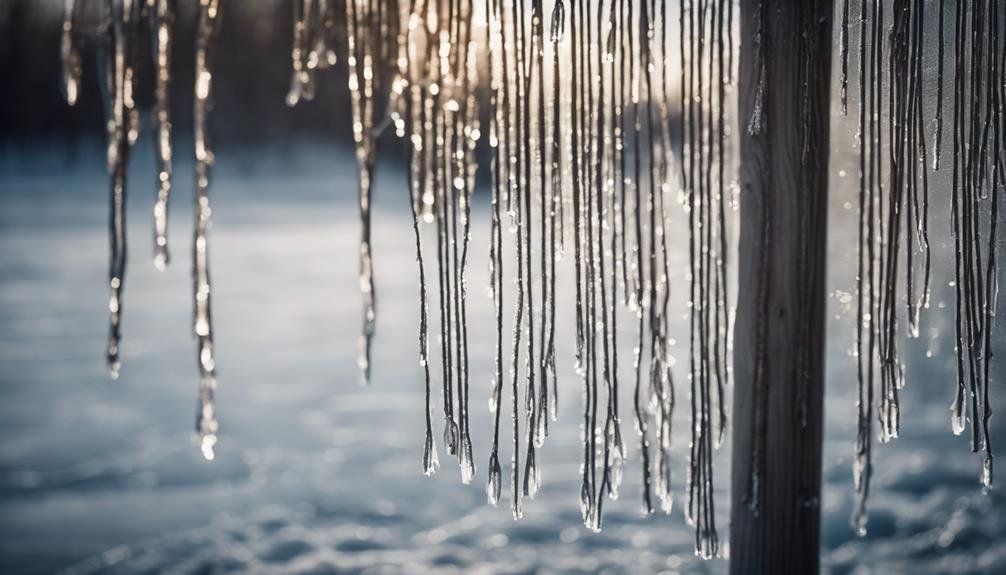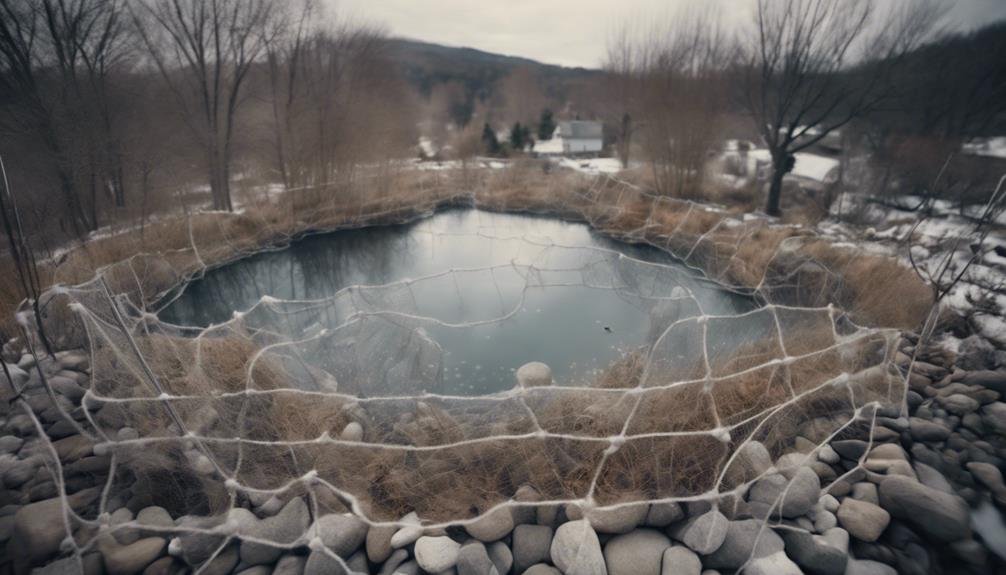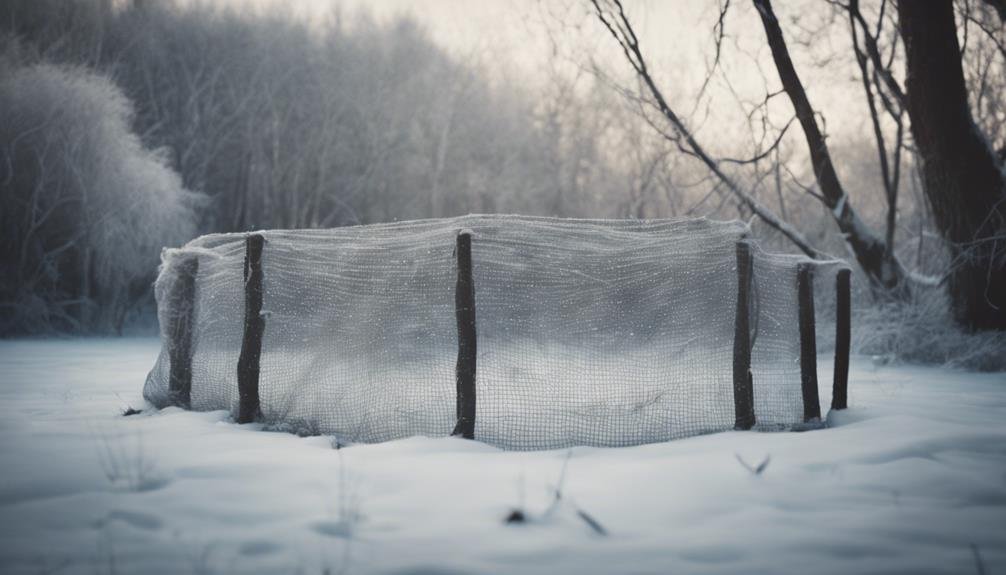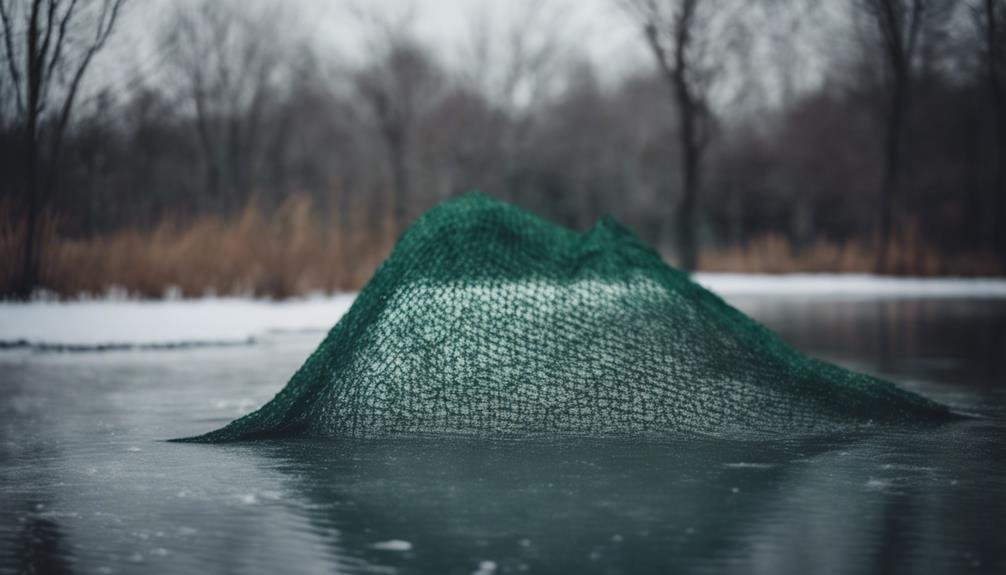In this guide, we will outline the essential steps for effectively using netting to protect ponds during the challenges of winter.
Some of the links in this article may be affiliate links. If you make a purchase through these links, we may earn a small commission at no extra cost to you. Thank you.
Begin by choosing strong, UV-resistant netting with a suitable mesh size to ensure durability. Before installation, make sure to clear the pond surface of any debris or vegetation.
When securing the netting, bury the edges and evenly distribute weights along the perimeters to keep it in place. To deter wildlife, consider using motion sprinklers or reflective tape around the pond.
Regular monitoring is key, as it allows you to check the water quality, plant health, and the overall condition of the netting. Remember to remove the netting seasonally, handling it with care to prolong its lifespan.
By staying diligent with maintenance tasks, you can help your pond ecosystem thrive throughout the winter months. For comprehensive protection, we will delve into the installation of netting, effective securing techniques, and maintenance practices.
Winter Pond Challenges
Winter can bring challenges to backyard ponds, especially for the aquatic life within them. As temperatures drop, the surface of the water may freeze, trapping harmful gases underneath. This can lead to a lack of oxygen, endangering the fish and other pond inhabitants.
In addition, the weight of snow and ice can damage the pond's structure, potentially causing cracks or even collapse. Predators may also take advantage of the lack of protective vegetation during winter, posing a threat to the pond's ecosystem.
To protect ponds during this tough season, installing specialized netting can be a smart solution. These durable nets help maintain gas exchange, prevent debris buildup, and keep wildlife from accessing the pond area.
Netting Selection Criteria
When considering pond netting for winter protection, it's crucial to carefully assess the criteria for choosing the right netting. The selection of netting material, mesh size, and overall durability plays a significant role in ensuring effective safeguarding during the harsh winter season.
There are four key factors to consider when selecting netting for your pond:
- Material: Opt for netting made from durable materials such as polyethylene or nylon that can withstand severe weather conditions and resist tearing or fraying.
- Mesh Size: Select a mesh size that's small enough to prevent leaves, debris, and predators from entering the pond while still allowing proper water circulation and gas exchange.
- UV Resistance: Choose netting that's UV-resistant to prevent premature degradation due to exposure to sunlight.
- Weight and Strength: Ensure that the netting is strong enough to support the weight of snow, ice, and other debris that may accumulate on top of it during the winter months.
Pond Surface Preparation

To prepare the pond's surface before installing the netting, start by clearing away any floating debris and fallen leaves. This step is crucial to ensure a clean area for the netting to be placed effectively.
Additionally, it's essential to trim or remove any vegetation that could potentially get in the way of the netting or get tangled in it. By taking these steps, you'll create a smooth and obstacle-free surface for the netting to serve its purpose effectively in protecting the pond.
Clear Debris
It's important to clear debris from the pond regularly before installing netting to maintain its effectiveness. Taking the time to remove leaves, twigs, and other organic matter that has accumulated on the water's surface is crucial.
To clear debris effectively, start by skimming the surface using a long-handled net or pool skimmer to gather floating debris.
Next, use a rake or pond vacuum to eliminate any settled debris from the bottom of the pond.
It's also essential to clean the pond edges and the surrounding area thoroughly to prevent additional debris from entering the water.
Inspect the pond carefully and remove any remaining debris by hand if necessary.
Remove Vegetation
Before installing the pond netting, it's essential to clear any aquatic vegetation from the surface of the pond. This process helps improve the effectiveness of the netting installation by preventing any interference from floating or emergent plants. Common aquatic plants that should be removed include duckweed, watermeal, water lilies, cattails, and algae.
Duckweed and watermeal are small, green, free-floating plants that can be removed by skimming or raking. Water lilies, with their floating leaves and flowers, should have their stems cut below the water surface. Cattails, tall reed-like plants, require digging out the roots for complete removal. Algae, characterized by green, slimy growth, can be manually removed or treated with chemicals.
Clearing the pond surface of these plants ensures a smooth and unobstructed area for the netting to be installed effectively. Additionally, trimming back overhanging branches and vegetation around the pond's edge is recommended to prevent future growth beneath the netting.
Proper preparation of the pond's surface is crucial for protecting it during the winter months.
Proper Netting Installation
Properly installing the netting over your pond in winter is crucial for ensuring maximum protection.
To begin, measure your pond's dimensions to determine the right size netting needed.
Next, anchor the netting securely around the pond's perimeter using stakes, bricks, or landscape edging. Make sure to stretch the netting tightly to prevent any sagging or water/snow accumulation.
Regularly check the netting and adjust as necessary to maintain proper tension throughout the season.
Securing Netting Edges

To prevent wildlife from entering, we'll secure the edges of the netting around the pond. One way to do this is by burying the perimeter securely.
Alternatively, you can also use rocks or sandbags to weigh down the edges effectively. Both methods ensure that the netting remains firmly in place, safeguarding our pond throughout the winter.
Bury Edges
To ensure the netting stays in place and offers protection during the winter, it's important to bury the edges securely. This helps prevent shifting and lifting due to strong winds.
Here's how you can bury the edges effectively:
Start by digging a trench all around the pond, about 6-8 inches deep and 6 inches wide. Carefully lay the netting edges flat in the trench, making sure they're secure. Use landscaping stakes or large rocks to weigh down the netting and keep it in place. Fill the trench with soil, packing it down firmly to secure the edges.
By burying the edges properly, you can avoid gaps that might allow debris, leaves, or animals to get into the pond. Remember to check the buried edges regularly throughout the winter to ensure they stay covered and secure.
Taking these steps will help protect your pond and its inhabitants during the harsh winter months.
Weigh Down Perimeters
Securing the netting by placing weights along its perimeters is crucial for keeping it in place during winter. To prevent strong winds from dislodging the netting and exposing the pond, we can use weights like bricks or sandbags.
The key is to distribute the weights evenly, spacing them about 2-3 feet apart to avoid any gaps that could allow the netting to billow upwards. This helps in blocking debris, snow, or wildlife from entering the pond area.
For ponds with irregular shapes, it's important to carefully follow the contours with the weights. Pay close attention to corners and curved sections where wind can easily get under the netting. These areas are prone to lifting, so adding extra weights there's a good precaution.
By properly weighing down the perimeters and burying the edges, we can ensure a secure fit over the pond, preventing any shifting or loosening of the netting until spring.
Taking the time to secure the netting in this way will help protect the pond from winter hazards. By following these steps diligently, we can maintain a clear water surface and keep our ponds safe throughout the colder months.
Ventilation and Lighting
Proper airflow and lighting are crucial factors to consider when covering ponds with nets in winter. It's essential to ensure adequate ventilation and illumination underneath the netting to maintain the health of aquatic plants and animals.
Ventilation plays a significant role in pond management for several reasons. Firstly, it enables the exchange of gases, allowing oxygen to dissolve into the water and carbon dioxide to escape. Moreover, proper ventilation prevents the accumulation of harmful gases and compounds that can result from stagnant conditions. It also helps in stabilizing water temperature, preventing drastic fluctuations that can stress aquatic life. Additionally, adequate airflow promotes healthy water circulation, which is essential for distributing nutrients and preventing debris buildup.
When it comes to lighting, it's important to mimic natural conditions to support photosynthesis in aquatic plants. This can be achieved by strategically placing grow lights or supplemental lighting under the netting. Opting for translucent netting materials that allow natural light penetration is also beneficial.
Adapting lighting schedules to simulate seasonal changes in daylight hours can further enhance plant growth. It's crucial to monitor plant health and adjust lighting as necessary to ensure optimal growth conditions.
Wildlife Deterrence Strategies

To protect ponds from wildlife intrusion in winter, effective deterrence strategies are essential under the protective netting. Placing deterrents like motion-activated sprinklers, ultrasonic devices, or reflective tape strategically around the perimeter can discourage animals from approaching the pond area.
Decoy predators like realistic owl or coyote decoys can also help deter smaller animals, such as rodents or birds. It's important to periodically move these decoys to different locations to maintain their effectiveness.
Natural repellents like cayenne pepper or garlic can be used around the netting's perimeter to deter animals with a strong sense of smell.
Maintaining a clear perimeter around the netting by removing potential hiding spots or food sources can further discourage wildlife from lingering in the area. Regular monitoring and maintenance of these deterrence strategies are crucial to ensure the ongoing protection of ponds throughout the winter months.
Seasonal Netting Removal
As we prepare to remove the netting from our ponds after winter, it's essential to ensure a smooth transition for the ecosystem. This process requires attention to detail and careful planning.
Here are four important steps to follow:
- Keep a close eye on the weather forecast and wait for consistent warmer temperatures before taking down the netting. This will help prevent any sudden changes in weather from disrupting the ecosystem.
- Before removing the netting, carefully check for any wildlife that may have become trapped, such as birds or small mammals. Safely release them back into their natural habitat before proceeding with the removal.
- When rolling up the netting, be gentle to avoid damaging any vegetation around the pond. This will help maintain the balance of the ecosystem and prevent any unnecessary disturbances.
- After removing the netting, store it in a dry and secure location until it's needed again next winter. Proper storage will help prolong the life of the netting and ensure it's ready for future use.
Maintenance and Inspection

After removing the netting, it's crucial to regularly inspect the pond for any issues that may arise. By keeping a close eye on the water quality, temperature, and clarity, as well as observing the fish and plants for any abnormalities, we can catch problems early on. If we notice algae blooms, discolored water, or fish in distress, immediate action is necessary. This may involve adjusting water conditions, adding beneficial bacteria, or seeking professional help if needed.
Furthermore, it's important to check the pond's structure for any damage like cracks or leaks that might've occurred during maintenance. Routine tasks such as cleaning filters, trimming plants, and clearing debris help maintain a healthy pond ecosystem. By staying proactive and addressing issues promptly, we can ensure the pond remains balanced and thriving.
Conclusion
By carefully installing and securing nets over our ponds, and keeping a watchful eye, we can protect them from the harsh winter conditions.
This prevents the formation of dangerous ice layers that could harm our aquatic habitat, ensuring our fish friends stay safe until the arrival of spring.
Our dedication to this task guarantees that our ponds will stay intact, full of life, and ready to thrive when the new season begins.

